JEEP GRAND CHEROKEE 2013 WK2 / 4.G Owners Manual
Manufacturer: JEEP, Model Year: 2013, Model line: GRAND CHEROKEE, Model: JEEP GRAND CHEROKEE 2013 WK2 / 4.GPages: 704, PDF Size: 5.14 MB
Page 471 of 704
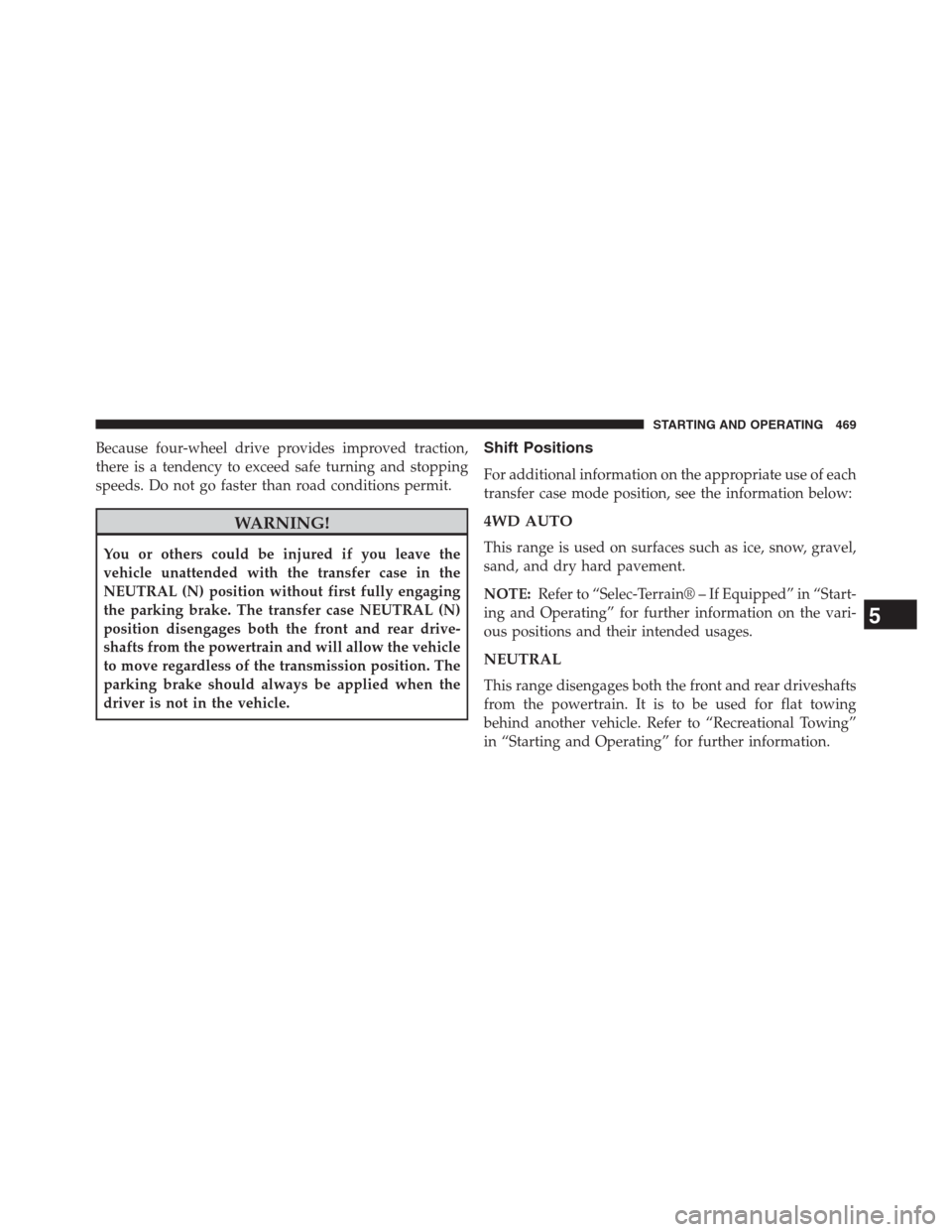
Because four-wheel drive provides improved traction,
there is a tendency to exceed safe turning and stopping
speeds. Do not go faster than road conditions permit.
WARNING!
You or others could be injured if you leave the
vehicle unattended with the transfer case in the
NEUTRAL (N) position without first fully engaging
the parking brake. The transfer case NEUTRAL (N)
position disengages both the front and rear drive-
shafts from the powertrain and will allow the vehicle
to move regardless of the transmission position. The
parking brake should always be applied when the
driver is not in the vehicle.
Shift Positions
For additional information on the appropriate use of each
transfer case mode position, see the information below:
4WD AUTO
This range is used on surfaces such as ice, snow, gravel,
sand, and dry hard pavement.
NOTE:Refer to “Selec-Terrain® – If Equipped” in “Start-
ing and Operating” for further information on the vari-
ous positions and their intended usages.
NEUTRAL
This range disengages both the front and rear driveshafts
from the powertrain. It is to be used for flat towing
behind another vehicle. Refer to “Recreational Towing”
in “Starting and Operating” for further information.
5
STARTING AND OPERATING 469
Page 472 of 704
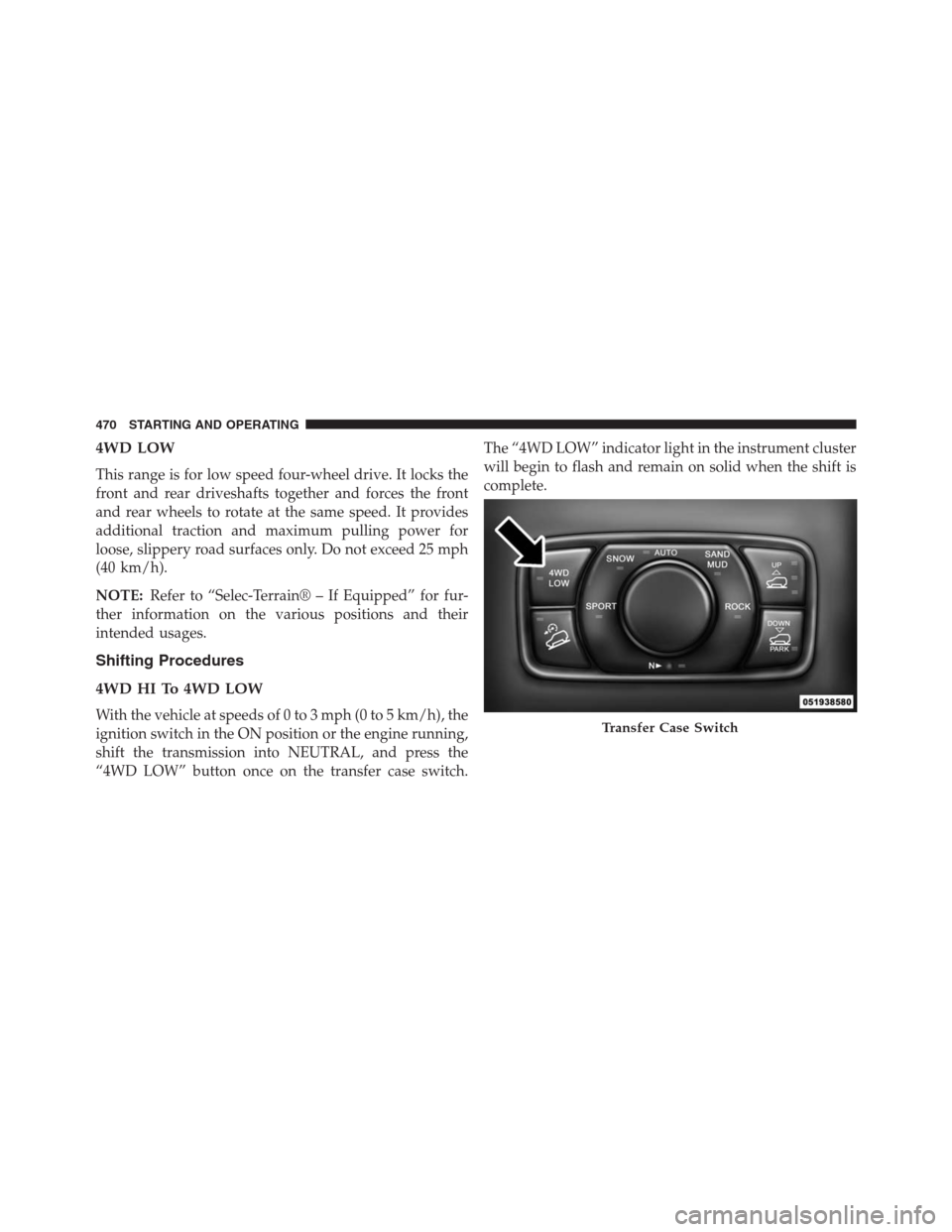
4WD LOW
This range is for low speed four-wheel drive. It locks the
front and rear driveshafts together and forces the front
and rear wheels to rotate at the same speed. It provides
additional traction and maximum pulling power for
loose, slippery road surfaces only. Do not exceed 25 mph
(40 km/h).
NOTE:Refer to “Selec-Terrain® – If Equipped” for fur-
ther information on the various positions and their
intended usages.
Shifting Procedures
4WDHITo4WDLOW
With the vehicle at speeds of 0 to 3 mph (0 to 5 km/h), the
ignition switch in the ON position or the engine running,
shift the transmission into NEUTRAL, and press the
“4WD LOW” button once on the transfer case switch.The “4WD LOW” indicator light in the instrument cluster
will begin to flash and remain on solid when the shift is
complete.Transfer Case Switch
470 STARTING AND OPERATING
Page 473 of 704
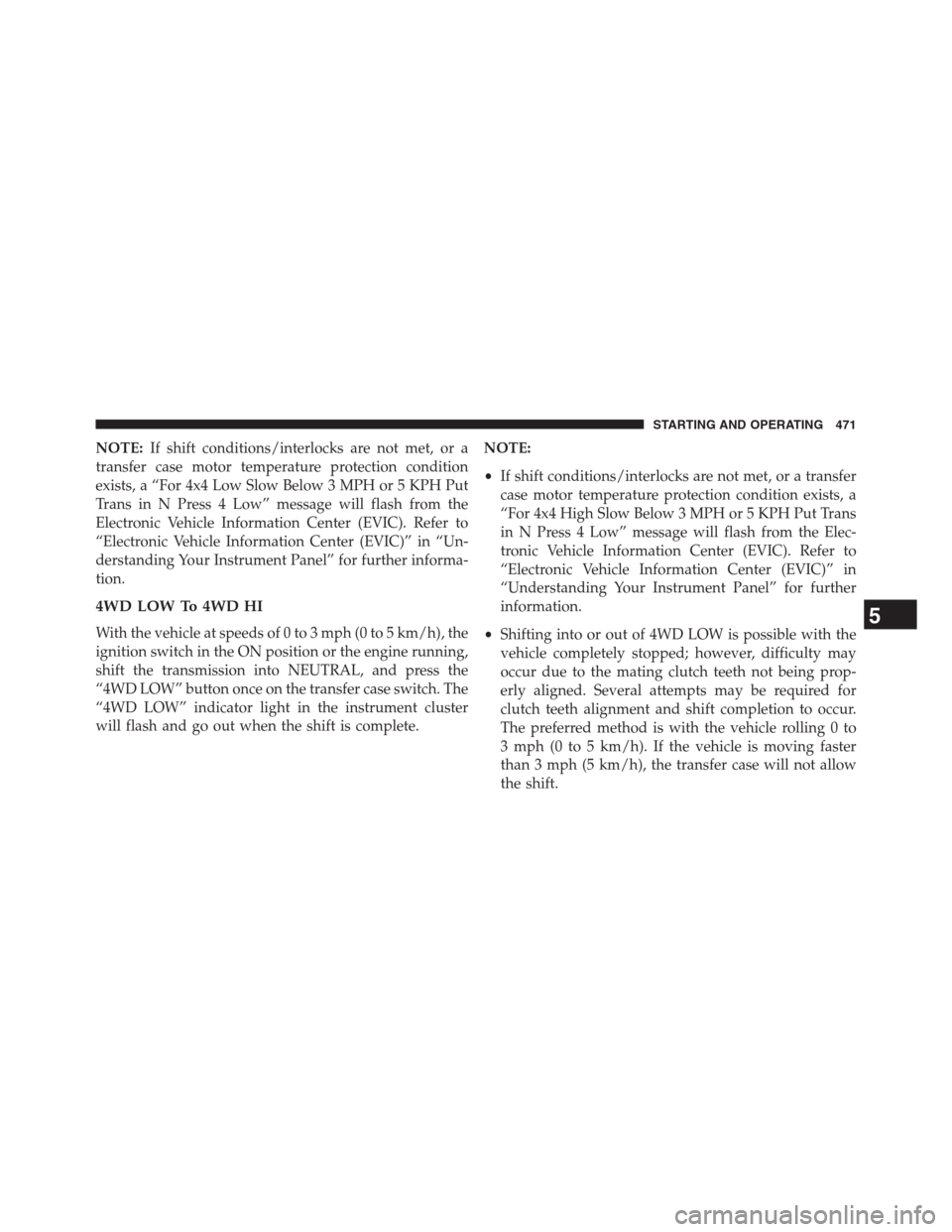
NOTE:If shift conditions/interlocks are not met, or a
transfer case motor temperature protection condition
exists, a “For 4x4 Low Slow Below 3 MPH or 5 KPH Put
Trans in N Press 4 Low” message will flash from the
Electronic Vehicle Information Center (EVIC). Refer to
“Electronic Vehicle Information Center (EVIC)” in “Un-
derstanding Your Instrument Panel” for further informa-
tion.
4WD LOW To 4WD HI
With the vehicle at speeds of 0 to 3 mph (0 to 5 km/h), the
ignition switch in the ON position or the engine running,
shift the transmission into NEUTRAL, and press the
“4WD LOW” button once on the transfer case switch. The
“4WD LOW” indicator light in the instrument cluster
will flash and go out when the shift is complete.NOTE:
•If shift conditions/interlocks are not met, or a transfer
case motor temperature protection condition exists, a
“For 4x4 High Slow Below 3 MPH or 5 KPH Put Trans
in N Press 4 Low” message will flash from the Elec-
tronic Vehicle Information Center (EVIC). Refer to
“Electronic Vehicle Information Center (EVIC)” in
“Understanding Your Instrument Panel” for further
information.
•Shifting into or out of 4WD LOW is possible with the
vehicle completely stopped; however, difficulty may
occur due to the mating clutch teeth not being prop-
erly aligned. Several attempts may be required for
clutch teeth alignment and shift completion to occur.
The preferred method is with the vehicle rolling 0 to
3 mph (0 to 5 km/h). If the vehicle is moving faster
than 3 mph (5 km/h), the transfer case will not allow
the shift.5
STARTING AND OPERATING 471
Page 474 of 704
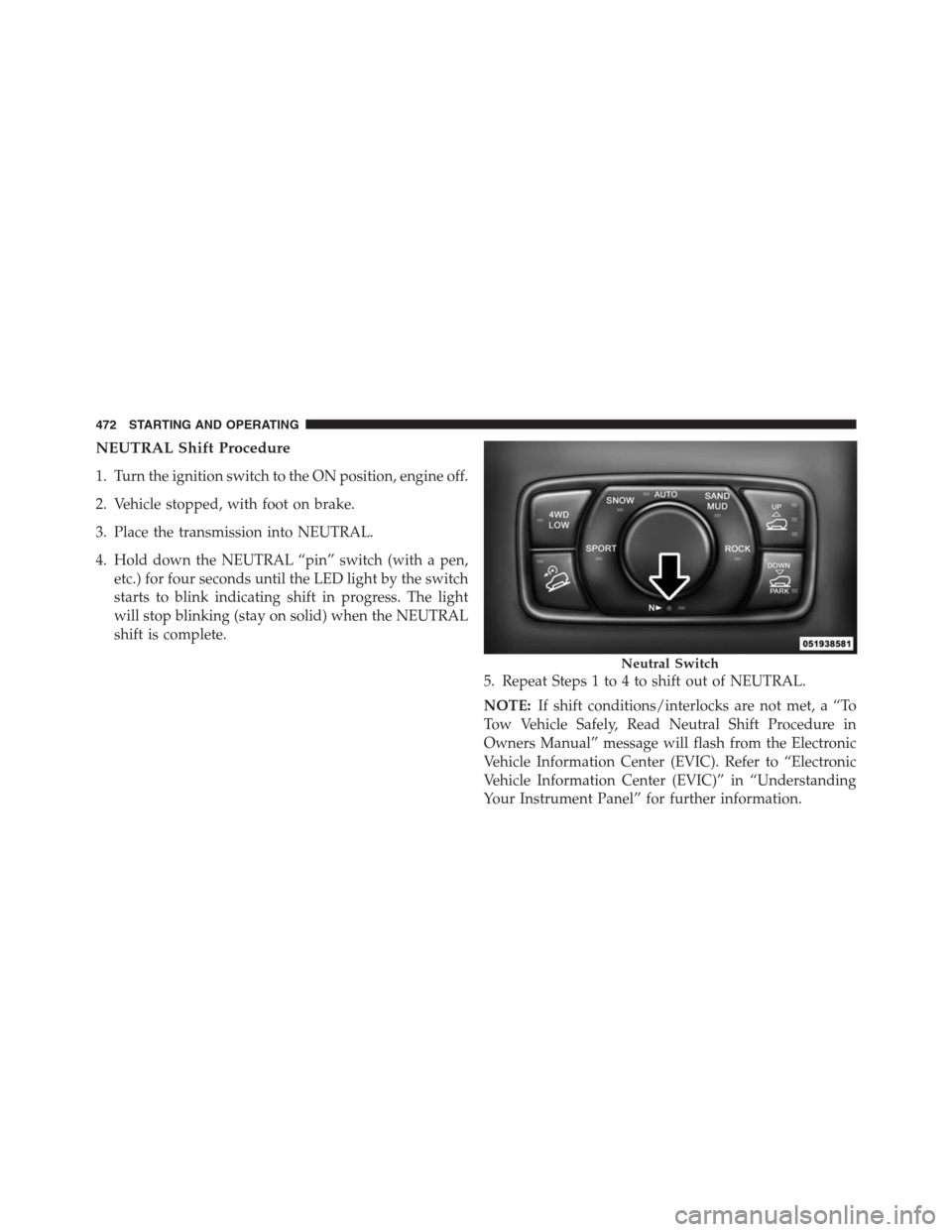
NEUTRAL Shift Procedure
1. Turn the ignition switch to the ON position, engine off.
2. Vehicle stopped, with foot on brake.
3. Place the transmission into NEUTRAL.
4. Hold down the NEUTRAL “pin” switch (with a pen,
etc.) for four seconds until the LED light by the switch
starts to blink indicating shift in progress. The light
will stop blinking (stay on solid) when the NEUTRAL
shift is complete.
5. Repeat Steps 1 to 4 to shift out of NEUTRAL.
NOTE:If shift conditions/interlocks are not met, a “To
Tow Vehicle Safely, Read Neutral Shift Procedure in
Owners Manual” message will flash from the Electronic
Vehicle Information Center (EVIC). Refer to “Electronic
Vehicle Information Center (EVIC)” in “Understanding
Your Instrument Panel” for further information.
Neutral Switch
472 STARTING AND OPERATING
Page 475 of 704
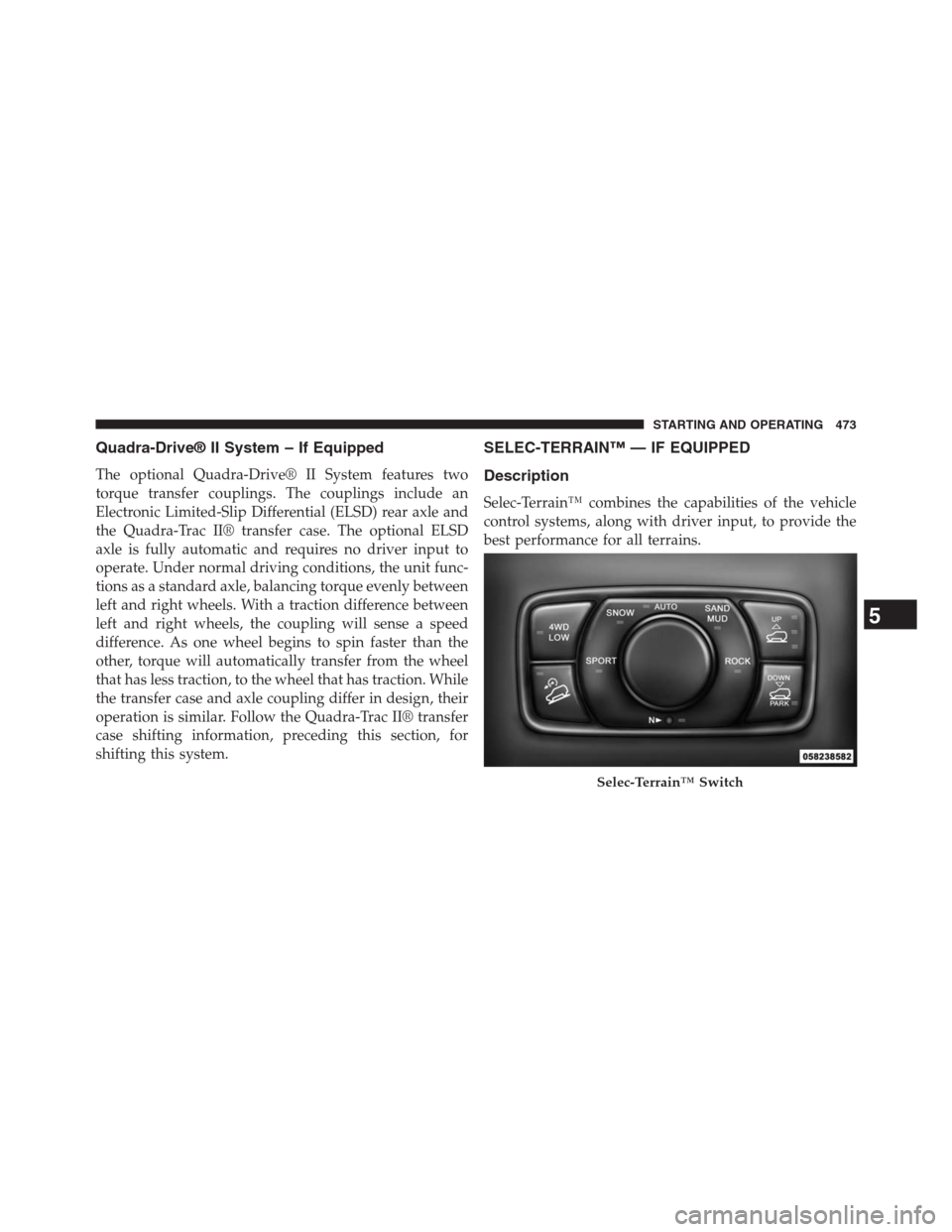
Quadra-Drive® II System – If Equipped
The optional Quadra-Drive® II System features two
torque transfer couplings. The couplings include an
Electronic Limited-Slip Differential (ELSD) rear axle and
the Quadra-Trac II® transfer case. The optional ELSD
axle is fully automatic and requires no driver input to
operate. Under normal driving conditions, the unit func-
tions as a standard axle, balancing torque evenly between
left and right wheels. With a traction difference between
left and right wheels, the coupling will sense a speed
difference. As one wheel begins to spin faster than the
other, torque will automatically transfer from the wheel
that has less traction, to the wheel that has traction. While
the transfer case and axle coupling differ in design, their
operation is similar. Follow the Quadra-Trac II® transfer
case shifting information, preceding this section, for
shifting this system.
SELEC-TERRAIN™ — IF EQUIPPED
Description
Selec-Terrain™ combines the capabilities of the vehicle
control systems, along with driver input, to provide the
best performance for all terrains.
Selec-Terrain™ Switch
5
STARTING AND OPERATING 473
Page 476 of 704
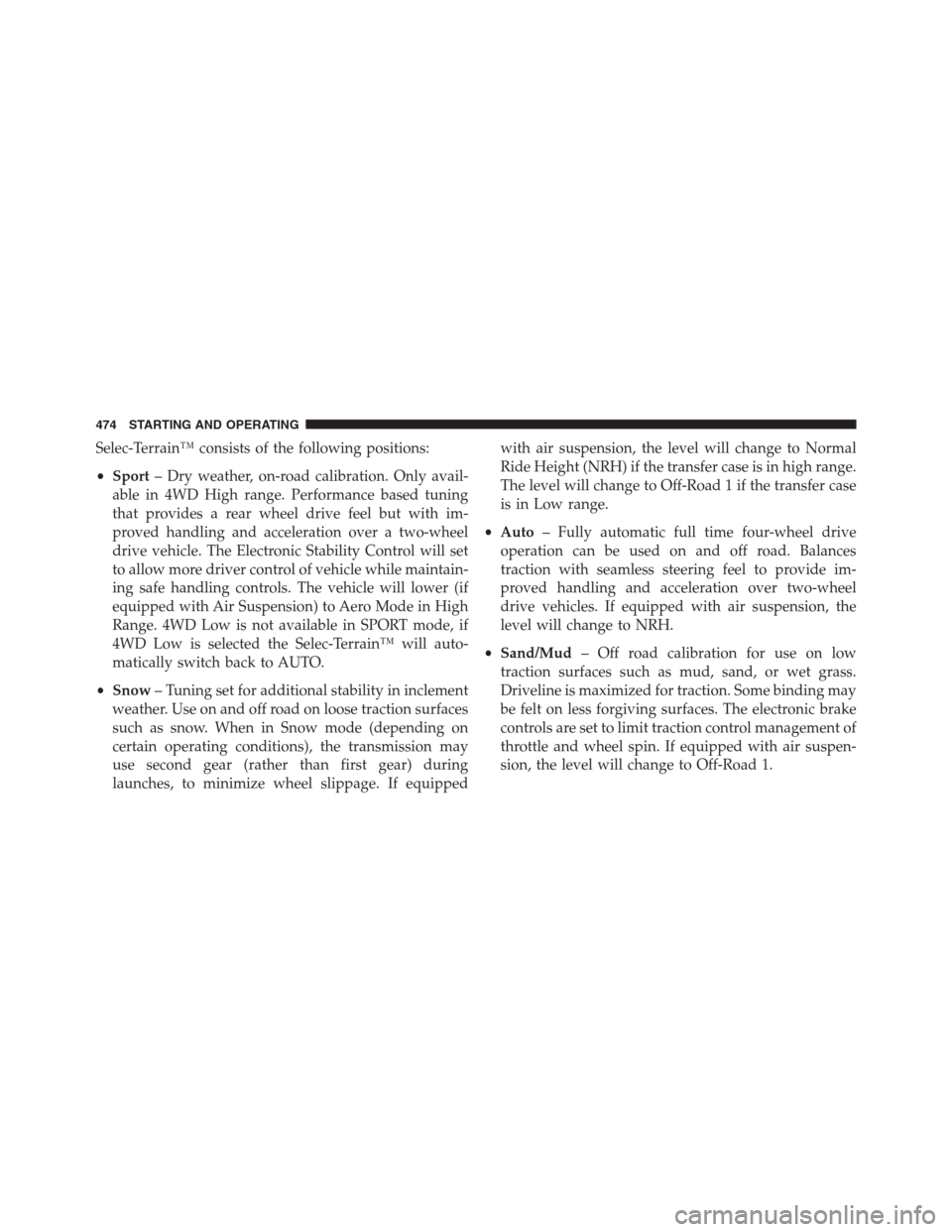
Selec-Terrain™ consists of the following positions:
•Sport– Dry weather, on-road calibration. Only avail-
able in 4WD High range. Performance based tuning
that provides a rear wheel drive feel but with im-
proved handling and acceleration over a two-wheel
drive vehicle. The Electronic Stability Control will set
to allow more driver control of vehicle while maintain-
ing safe handling controls. The vehicle will lower (if
equipped with Air Suspension) to Aero Mode in High
Range. 4WD Low is not available in SPORT mode, if
4WD Low is selected the Selec-Terrain™ will auto-
matically switch back to AUTO.
•Snow– Tuning set for additional stability in inclement
weather. Use on and off road on loose traction surfaces
such as snow. When in Snow mode (depending on
certain operating conditions), the transmission may
use second gear (rather than first gear) during
launches, to minimize wheel slippage. If equippedwith air suspension, the level will change to Normal
Ride Height (NRH) if the transfer case is in high range.
The level will change to Off-Road 1 if the transfer case
is in Low range.
•Auto– Fully automatic full time four-wheel drive
operation can be used on and off road. Balances
traction with seamless steering feel to provide im-
proved handling and acceleration over two-wheel
drive vehicles. If equipped with air suspension, the
level will change to NRH.
•Sand/Mud– Off road calibration for use on low
traction surfaces such as mud, sand, or wet grass.
Driveline is maximized for traction. Some binding may
be felt on less forgiving surfaces. The electronic brake
controls are set to limit traction control management of
throttle and wheel spin. If equipped with air suspen-
sion, the level will change to Off-Road 1.
474 STARTING AND OPERATING
Page 477 of 704
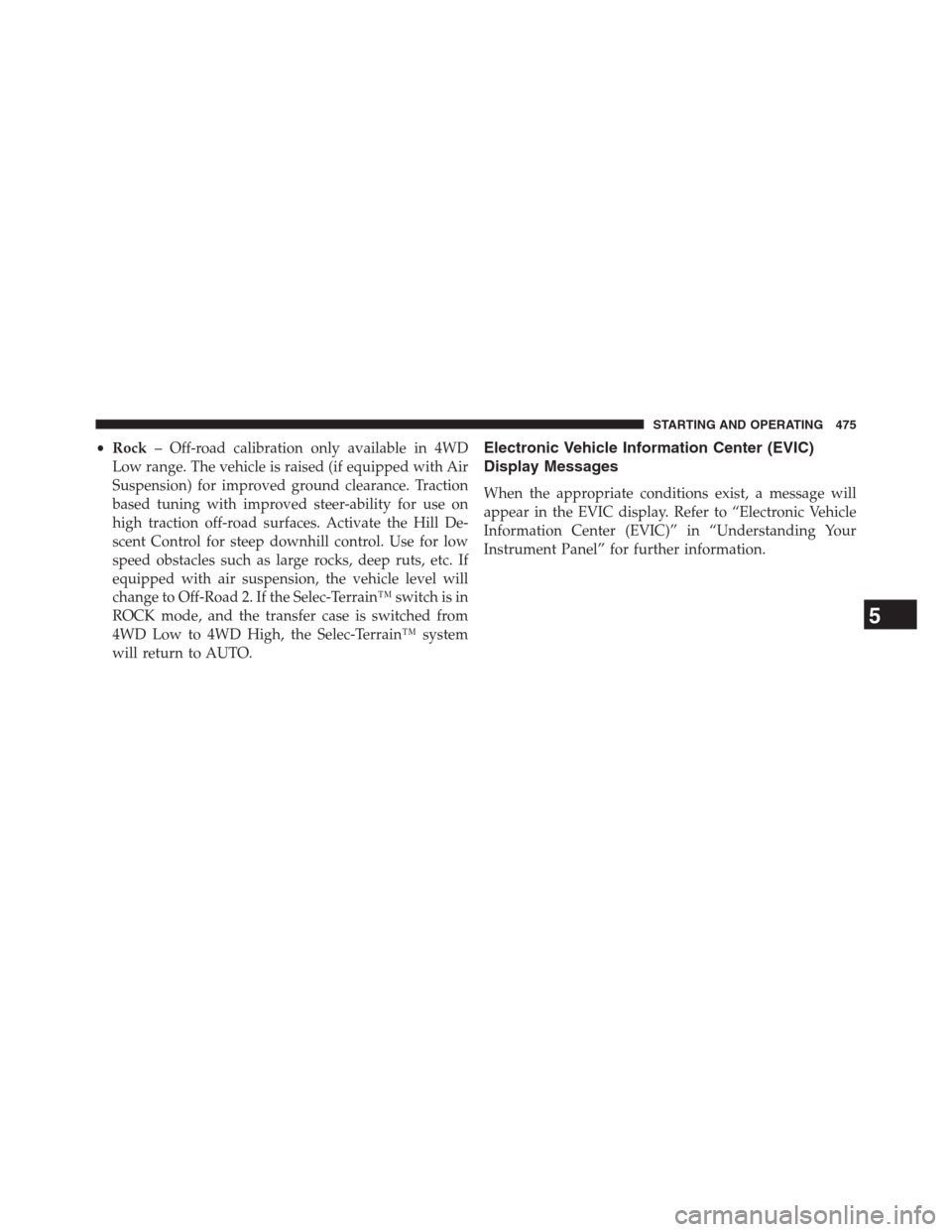
•Rock– Off-road calibration only available in 4WD
Low range. The vehicle is raised (if equipped with Air
Suspension) for improved ground clearance. Traction
based tuning with improved steer-ability for use on
high traction off-road surfaces. Activate the Hill De-
scent Control for steep downhill control. Use for low
speed obstacles such as large rocks, deep ruts, etc. If
equipped with air suspension, the vehicle level will
change to Off-Road 2. If the Selec-Terrain™ switch is in
ROCK mode, and the transfer case is switched from
4WD Low to 4WD High, the Selec-Terrain™ system
will return to AUTO.Electronic Vehicle Information Center (EVIC)
Display Messages
When the appropriate conditions exist, a message will
appear in the EVIC display. Refer to “Electronic Vehicle
Information Center (EVIC)” in “Understanding Your
Instrument Panel” for further information.
5
STARTING AND OPERATING 475
Page 478 of 704
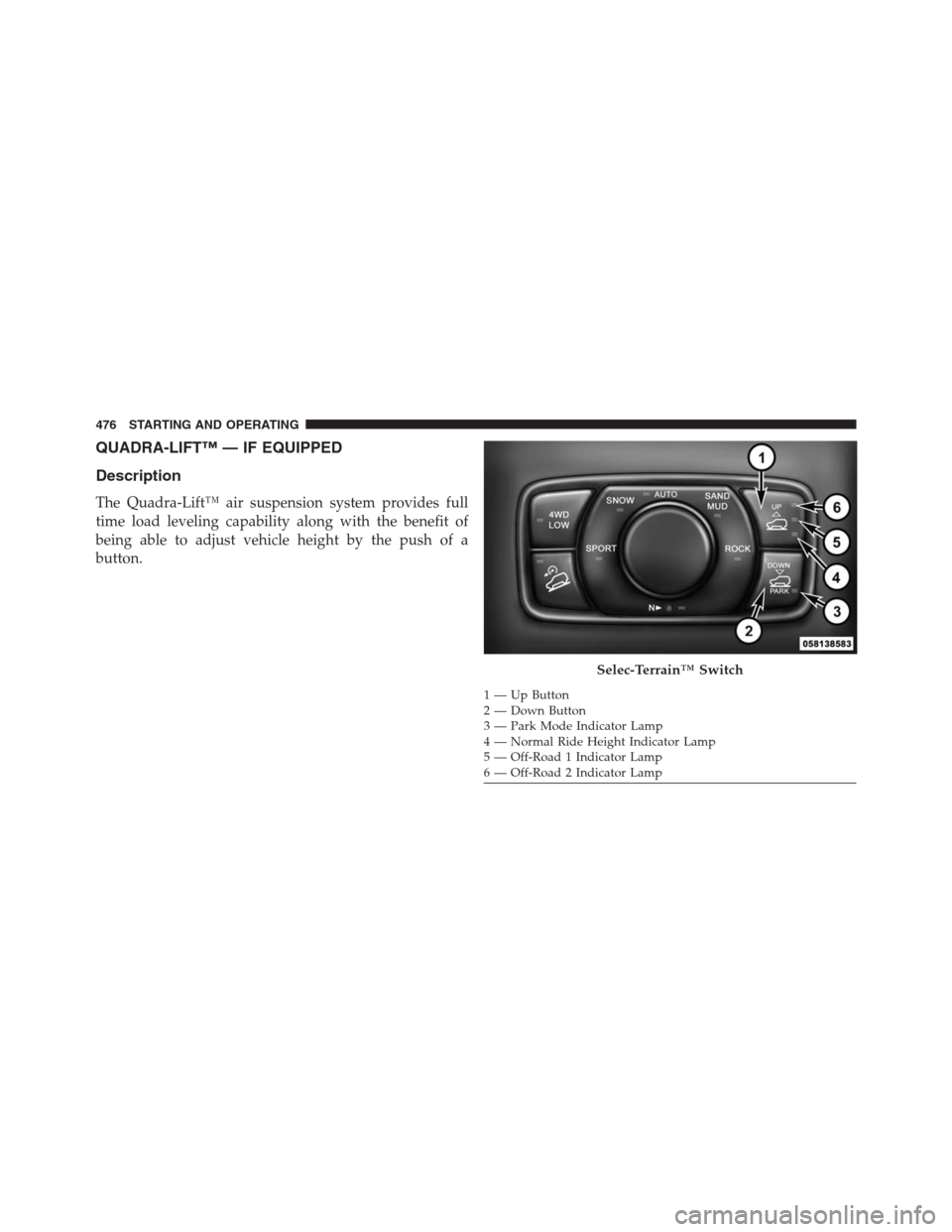
QUADRA-LIFT™ — IF EQUIPPED
Description
The Quadra-Lift™ air suspension system provides full
time load leveling capability along with the benefit of
being able to adjust vehicle height by the push of a
button.
Selec-Terrain™ Switch
1 — Up Button
2 — Down Button
3 — Park Mode Indicator Lamp
4 — Normal Ride Height Indicator Lamp
5 — Off-Road 1 Indicator Lamp
6 — Off-Road 2 Indicator Lamp 476 STARTING AND OPERATING
Page 479 of 704
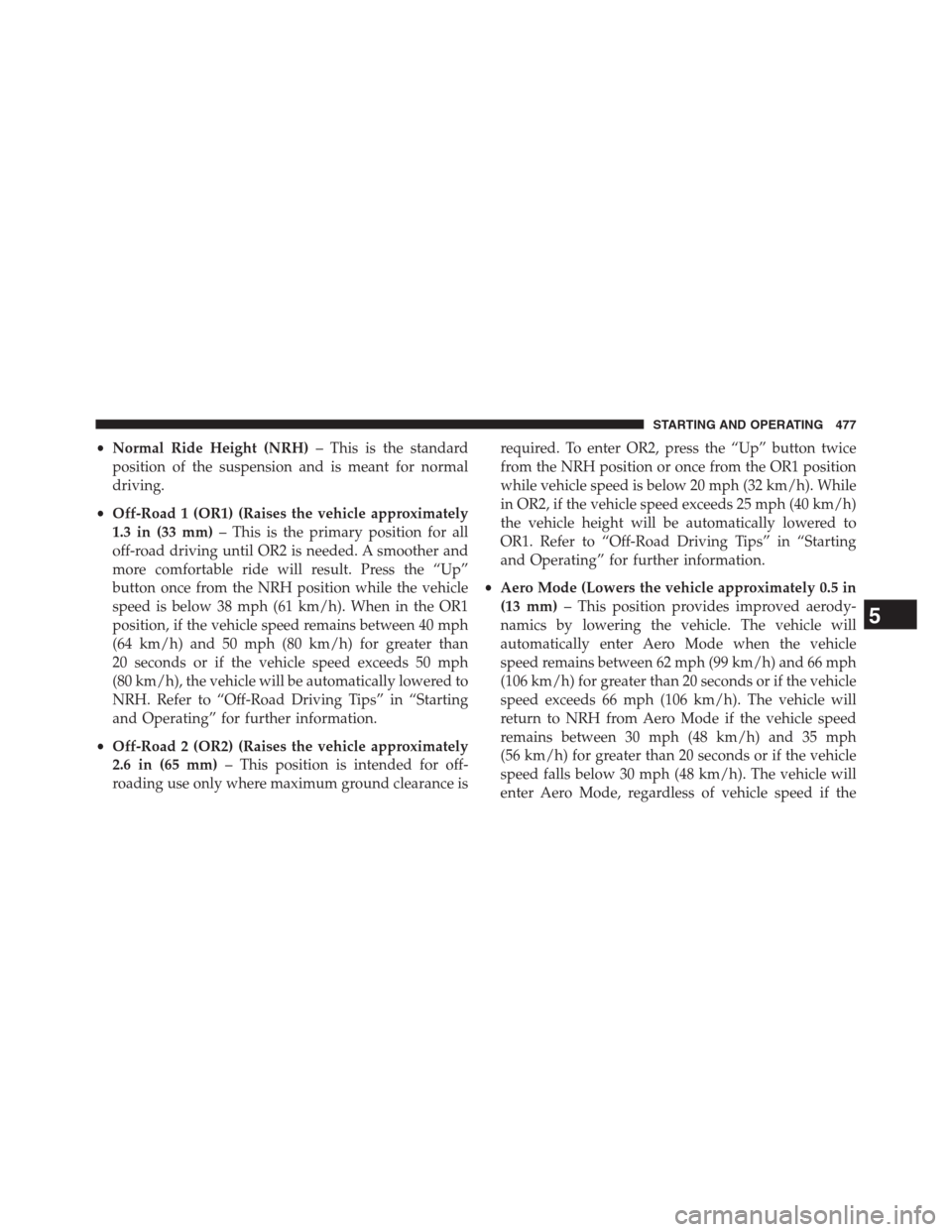
•Normal Ride Height (NRH)– This is the standard
position of the suspension and is meant for normal
driving.
•Off-Road 1 (OR1) (Raises the vehicle approximately
1.3 in (33 mm)– This is the primary position for all
off-road driving until OR2 is needed. A smoother and
more comfortable ride will result. Press the “Up”
button once from the NRH position while the vehicle
speed is below 38 mph (61 km/h). When in the OR1
position, if the vehicle speed remains between 40 mph
(64 km/h) and 50 mph (80 km/h) for greater than
20 seconds or if the vehicle speed exceeds 50 mph
(80 km/h), the vehicle will be automatically lowered to
NRH. Refer to “Off-Road Driving Tips” in “Starting
and Operating” for further information.
•Off-Road 2 (OR2) (Raises the vehicle approximately
2.6 in (65 mm)– This position is intended for off-
roading use only where maximum ground clearance isrequired. To enter OR2, press the “Up” button twice
from the NRH position or once from the OR1 position
while vehicle speed is below 20 mph (32 km/h). While
in OR2, if the vehicle speed exceeds 25 mph (40 km/h)
the vehicle height will be automatically lowered to
OR1. Refer to “Off-Road Driving Tips” in “Starting
and Operating” for further information.
•Aero Mode (Lowers the vehicle approximately 0.5 in
(13 mm)– This position provides improved aerody-
namics by lowering the vehicle. The vehicle will
automatically enter Aero Mode when the vehicle
speed remains between 62 mph (99 km/h) and 66 mph
(106 km/h) for greater than 20 seconds or if the vehicle
speed exceeds 66 mph (106 km/h). The vehicle will
return to NRH from Aero Mode if the vehicle speed
remains between 30 mph (48 km/h) and 35 mph
(56 km/h) for greater than 20 seconds or if the vehicle
speed falls below 30 mph (48 km/h). The vehicle will
enter Aero Mode, regardless of vehicle speed if the
5
STARTING AND OPERATING 477
Page 480 of 704
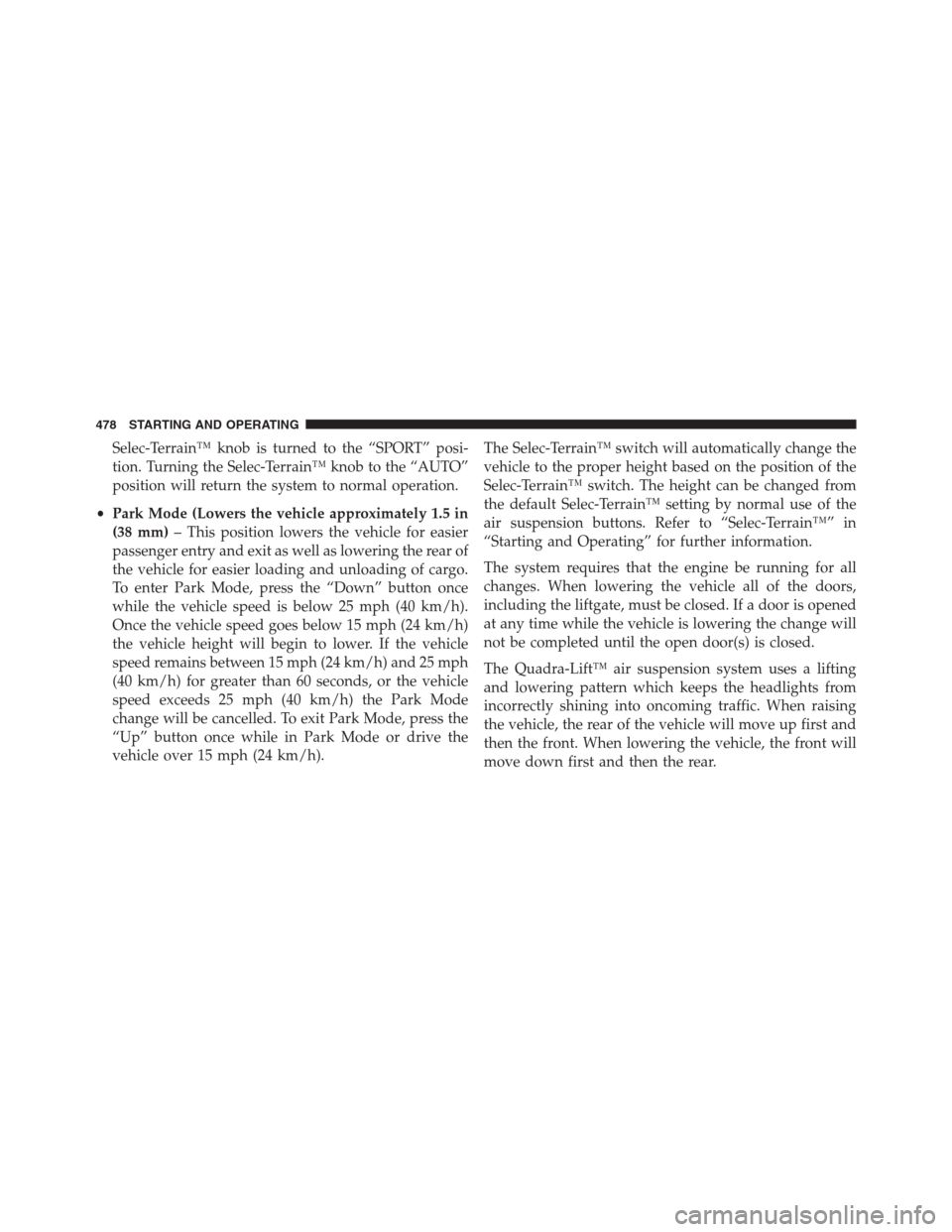
Selec-Terrain™ knob is turned to the “SPORT” posi-
tion. Turning the Selec-Terrain™ knob to the “AUTO”
position will return the system to normal operation.
•Park Mode (Lowers the vehicle approximately 1.5 in
(38 mm)– This position lowers the vehicle for easier
passenger entry and exit as well as lowering the rear of
the vehicle for easier loading and unloading of cargo.
To enter Park Mode, press the “Down” button once
while the vehicle speed is below 25 mph (40 km/h).
Once the vehicle speed goes below 15 mph (24 km/h)
the vehicle height will begin to lower. If the vehicle
speed remains between 15 mph (24 km/h) and 25 mph
(40 km/h) for greater than 60 seconds, or the vehicle
speed exceeds 25 mph (40 km/h) the Park Mode
change will be cancelled. To exit Park Mode, press the
“Up” button once while in Park Mode or drive the
vehicle over 15 mph (24 km/h).The Selec-Terrain™ switch will automatically change the
vehicle to the proper height based on the position of the
Selec-Terrain™ switch. The height can be changed from
the default Selec-Terrain™ setting by normal use of the
air suspension buttons. Refer to “Selec-Terrain™” in
“Starting and Operating” for further information.
The system requires that the engine be running for all
changes. When lowering the vehicle all of the doors,
including the liftgate, must be closed. If a door is opened
at any time while the vehicle is lowering the change will
not be completed until the open door(s) is closed.
The Quadra-Lift™ air suspension system uses a lifting
and lowering pattern which keeps the headlights from
incorrectly shining into oncoming traffic. When raising
the vehicle, the rear of the vehicle will move up first and
then the front. When lowering the vehicle, the front will
move down first and then the rear.
478 STARTING AND OPERATING